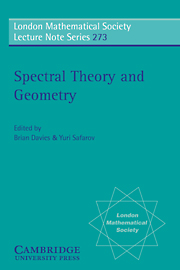Book contents
- Frontmatter
- Contents
- 1 Preface
- 2 List of lecture courses
- 3 List of participants
- 4 Basic Riemannian geometry
- 5 The Laplacian on Riemannian manifolds
- 6 Computational Spectral Theory
- 7 Isoperimetric and universal inequalities for eigenvalues
- 8 Estimates of heat kernels on Riemannian manifolds
- 9 Spectral theory of the Schrödinger operators on noncompact manifolds: qualitative results
- 10 Lectures on wave invariants
6 - Computational Spectral Theory
Published online by Cambridge University Press: 08 January 2010
- Frontmatter
- Contents
- 1 Preface
- 2 List of lecture courses
- 3 List of participants
- 4 Basic Riemannian geometry
- 5 The Laplacian on Riemannian manifolds
- 6 Computational Spectral Theory
- 7 Isoperimetric and universal inequalities for eigenvalues
- 8 Estimates of heat kernels on Riemannian manifolds
- 9 Spectral theory of the Schrödinger operators on noncompact manifolds: qualitative results
- 10 Lectures on wave invariants
Summary
Abstract Spectral Theory
The material in this section is standard theory which may be found in many textbooks, for example [4] which I follow closely. Much more comprehensive accounts are given in [11, 8], which are rightly regarded as classic accounts of the subject. My goal in these lectures is not to describe new research, but to provide students with the basic knowledge needed to follow the later and more advanced courses. However, in the third lecture I indulge myself somewhat by describing spectral theory from a computational point of view which will be familiar to numerical analysts, but not to most mathematicians and mathematical physicists. This lecture contains recent research material.
Let H be a separable Hilbert space, such as L2(U) where U is a region in RN, and let A be a differential operator acting in H it is common to abuse language and say that A acts in U. Since not all functions in H are differentiate the domain of A cannot be the whole of H, and we assume that it is a dense linear subspace Dom(H) of H. The precise choice of this subspace is both important and difficult in many cases. One often starts with a domain smaller than the final domain, which consists of suitably regular functions obeying the boundary conditions relevant to the operator in question, and then passes to a slightly larger domain by the following closure procedure.
- Type
- Chapter
- Information
- Spectral Theory and Geometry , pp. 76 - 94Publisher: Cambridge University PressPrint publication year: 1999



